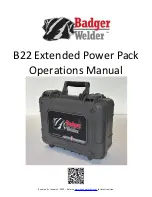
IM-MP 599345 0718 MegaPress XL (EN)
10
3.5 Welding requirements
The following requirements must be considered
when welding in the same vicinity as Viega
MegaPress XL fittings.
When pressing next to an existing weld joint, stay
1" away from the weld joint in order to ensure that
the press is not happening in the heat affected zone
of the weld joint.
3.5.1 Welding adjacent to Viega MegaPress XL
fittings
When welding adjacent to a Viega MegaPress XL
connection, the installer must remain 4" away from
the connection to prevent damage to the sealing
element. The installer should take the following
precautions to keep the Viega MegaPress XL
connection cool while welding:
• Wrapping the connection with a cold, wet rag
• Protecting the connection with a weld blanket
• Fabricating weld connections prior to
installing the pressed fitting, making sure the
pipe has cooled before installing the fitting
• Consistently applying heat sink gel or spray
3.5.2 Welding in line with Viega MegaPress XL
fittings
When welding in line with Viega MegaPress XL
fittings, the installer must remain a minimum of
three feet away from the Viega MegaPress XL
connection to prevent damage to the sealing
element. The installer should take the following
precautions to keep the Viega MegaPress XL
connection cool while welding:
• Wrapping the connection with a cold, wet rag
• Protecting the connection with a weld blanket
• Fabricating weld connections prior to
installing the pressed fitting, making sure the
pipe has cooled before installing the fitting
• Consistently applying heat sink gel or spray
3.6 General installation requirements
The Viega MegaPress XL fitting system must be
installed while considering the following general
industry requirements.
3.6.1 Expansion
Thermal expansion in installed systems generates
stresses in pipes and appliance connectors.
Compensation must be allowed for expansion
and contraction that may occur within the piping
system. Expansion joints or mechanical expansion
compensators may be used to alleviate these
stresses.
3.6.2 Electrical bonding
When properly installed, Viega MegaPress XL
fittings comply with Section 1211.15, Electrical
Bonding and Grounding, of the Uniform Plumbing
Code and Section 310 of the International Fuel Gas
Code.
The mechanical press provides continuous
metal-to-metal contact between fitting and pipe.
The press ensures the continuity of the bonding
through this contact.
3.6.3 Piping exposed to freezing temperatures
In the Viega MegaPress XL system, the FKM
sealing element can be installed in ambient
temperatures down to 14°F. Piping systems
exposed to freezing temperatures must be
protected per acceptable engineering practices,
codes and as required by the local authority.
3.6.4 Corrosion protection
Viega MegaPress XL fittings exposed to corrosive
action, such as soil conditions or moisture, must
be protected in an approved manner in accordance
with NFPA 54 Section 404.8, NACE Standard
RP0169-2002 Section 5, 2009 UPC Chapter 6
Section 609.3.1, 2009 UMC Chapter 13 Section
1312.1.3 and in a manner satisfactory to the local
code official.
Care should be taken to select hangers of suitable
material that is galvanically compatible with the
piping system. In addition, piping systems should
be properly sized to minimize the risk of erosion
corrosion resulting from excessive velocities.
3.6.5 Underground installations
Viega MegaPress XL fitting systems and black iron
pipe are approved for underground installations.
However, any installations must meet all state and
local codes, including those for underground.
Proper authorization must be obtained prior to
underground installation from the local authority
having jurisdiction.
3.6.6 Pressure testing
The pressure testing of installed pipe is to be
completed in accordance with local codes or, in
the absence of local codes, in accordance with
NFPA 54 or NFPA 58.
3.6.7 Transition connections
Viega MegaPress XL system 2½" to 4" can be
joined with off-the-shelf threaded fittings.
In this regard:
1. The threaded connection is made first.
2. The press connection is made second.
This process avoids unnecessary torsion.


































